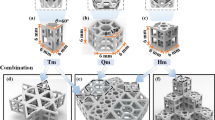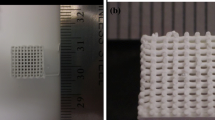Abstract
Multiple-layered scaffolds with diverse three-dimensional architectures have been successfully fabricated using additive manufacturing (AM) and can be used in tissue engineering.
Regarding the regular scaffolds that consist of a connected lattice of solid beams, various researches have been carried out, but multilayered scaffolds with this structure have been less studied. This research tries to investigate the factors affecting the mechanical properties by keeping the percentage of porosity constant. This study aimed to investigate the effect of unit cell shape, struts diameter, and number of layers on the mechanical properties of multiple-layered scaffolds with constant porosity. All the lattice scaffolds were designed in cylindrical form (outer diameter of 30 mm and length of 60 mm) and fabricated from 18 various types with 70% porosity, in single, double, and triple layers using the selective laser sintering (SLS) method. In all the samples, the outer layers had a higher density compared to the inner layers. The mechanical properties of the scaffolds were determined through uniform compression tests. The stress–strain curves of the samples revealed that as the struts diameter increases, the yield strength increases due to the reduction of manufacturing defects. This improvement in yield strength was greater in homogeneous scaffolds than in other scaffolds. Additionally, numerical simulations showed that the maximum strength occurred in the two-layer scaffolds. Furthermore, the position of the maximum radial displacement shifted from the middle region to the top and bottom regions of the scaffold with the increase in the number of layers. Based on the findings of this study, in scaffolds with constant porosity, increasing the number of layers and the diameter of the struts, without changing the Young’s modulus, can increase the yield strength of the scaffolds.













Similar content being viewed by others
References
Vaezi M, Seitz H, Yang S (2013) A review on 3D micro-additive manufacturing technologies. Int J Adv Manuf Technol 67(5–8):1721–1754
Ahn S, Chun D, Kim C (2011) Nanoscale hybrid manufacturing process by nano particle deposition system (NPDS) and focused ion beam (FIB). CIRP Ann Manuf Technol 60(1):583–586
Petrochenko PE, Torgersen J, Gruber P, Hicks LA, Zheng J, Kumar G, Narayan RJ, Goering PL, Liska R, Stampfl J (2015) Laser 3D printing with sub-microscale resolution of porous elastomeric scaffolds for supporting human bone stem cells. Adv Healthc Mater 4(5):739–747
Maskery I, Sturm L, Aremu AO, Panesar A, Williams CB, Tuck CJ, Wildman RD, Ashcroft IA, Hague RJM (2018) Insights into the mechanical properties of several triply periodic minimal surface lattice structures made by polymer additive manufacturing. Polymer 152:62–71
Refai K, Montemurro M, Brugger C, Saintier N (2019) Determination of the effective elastic properties of titanium lattice structures. Mech Adv Mater Struct 27:1966–1982
Pasquale GD, Montemurro M, Catapano A, Bertolino G, Revelli L (2018) Cellularstructures from additive processes: design, homogenization and experimental validation. Proc Struct Integr 8:75–82
Deshpande VS, Fleck NA (2001) Collapse of truss core sandwich beams in 3-point bending. Int J Solid Struct 38(36–37):6275–6305
Wang J, Evans AG, Dharmasena K, Wadley HNG (2003) On the performance of truss panels with Kagome cores. Int J Solid Struct 40(25):6981–6988
Kooistra GW, Deshpande VS, Wadley HNG (2004) Compressive behavior of age hardenable tetrahedral lattice truss structures made from aluminium. Acta Mater 52(14):4229–4237
Rathbun HJ, Wei Z, He MY, Zok FW, Evans AG, Sypeck DJ, Wadley HNG (2004) Measurement and simulation of the performance of a lightweight metallic sandwich structure with a tetrahedral truss core. J Appl Mech 71(3):368–374
Queheillalt DT, Wadley HNG (2005) Cellular metal lattices with hollow trusses. Acta Mater 53(2):303–313
Queheillalt DT, Wadley HNG (2005) Pyramidal lattice truss structures with hollow trusses. Mater Sci Eng A 397(1–2):132–137
Gibson LJ, Ashby MF (1997) Cellular solids: structure and properties. Cambridge University Press
Luxner MH, Woesz A, Stampfl J, Fratzl P, Pettermann HE (2009) A finite element study on the effects of disorder in cellular structures. Acta Biomater 5(1):381–390
Parthasarathy J, Starly B, Raman S, Christensen A (2010) Mechanical evaluation of porous titanium (Ti6Al4V) structures with electron beam melting (EBM). J Mech Behav Biomed Mater 3(3):249–259
Hedayati R, Sadighi M, Mohammadi-Aghdam M, Zadpoor AA (2016) Mechanical properties of regular porous biomaterials made from truncated cube repeating unit cells: analytical solutions and computational models. Mater Sci Eng C 60:163–183
Campoli G, Borleffs M, Yavari SA, Wauthle R, Weinans H, Zadpoor AA (2013) Mechanical properties of open-cell metallic biomaterials manufactured using additive manufacturing. Mater Des 49:957–965
Babaee S, Jahromi BH, Ajdari A, Nayeb-Hashemi H, Vaziri A (2012) Mechanical properties of open-cell rhombic dodecahedron cellular structures. Acta Mater 60(6):2873–2885
Borleffs M (2012) Finite element modeling to predict bulk mechanical properties of 3D printed metal foams. Delft University of Technology, TU Delft
Shulmeister V, Van der Burg M, Van der Giessen E, Marissen R (1998) A numerical study of large deformations of low-density elastomeric open-cell foams. Mech Mater 30(2):125–140
Hedayati R, Hosseini-Toudeshky H, Sadighi M, Mohammadi-Aghdam M, Zadpoor AA (2016) Computational prediction of the fatigue behavior of additively manufactured porous metallic biomaterials. Int J Fatigue 84:67–79
Hedayati R, Sadighi M, Mohammadi-Aghdam M, Zadpoor AA (2016) Mechanical behavior of additively manufactured porous biomaterials made from truncated cuboctahedron unit cells. Int J Mech Sci 106:19–38
Warren W, Kraynik A (1997) Linear elastic behavior of a low-density Kelvin foam with open cells. J Appl Mech 64:787–794
Zheng X, Lee H, Weisgraber TH, Shusteff M, DeOtte J, Duoss EB, Kuntz JD, Biener MM, Ge Q, Jackson JA (2014) Ultralight, ultrastiff mechanical metamaterials. Science 344(6190):1373–1377
Hedayati R, Sadighi M, Mohammadi-Aghdam M, Zadpoor AA (2016) Mechanics of additively manufactured porous biomaterials based on the rhombicuboctahedron unit cell. J Mech Behav Biomed Mater 53:272–294
Ptochos E, Labeas G (2012) Elastic modulus and Poisson’s ratio determination of microlattice cellular structures by analytical, numerical and homogenisation methods. J Sandw Struct Mater 14(5):597–626
Ptochos E, Labeas G (2012) Shear modulus determination of cuboid metallic open-lattice cellular structures by analytical, numerical and homogenisation methods. J Strain 48(5):415–429
Ahmadi S, Campoli G, Amin YS, Sajadi B, Wauthle R, Schrooten J, Weinans H, Zadpoor AA (2014) Mechanical behavior of regular open-cell porous biomaterials made of diamond lattice unit cells. J Mech Behav Biomed Mater 34:106–115
Hedayati R, Sadighi M, Mohammadi-Aghdam M, Zadpoor AA (2016) Effect of massmultiple counting on the elastic properties of opencell regular porous biomaterials. Mater Des 89:9–20
Bitsche R, Daxner T, B¨ohm HJ (2005) Space-Filling Polyhedra as Mechanical Models for Solidified Dry Foams. Technische Universit¨at Wien
Buffel B, Desplentere F, Bracke K, Verpoest I (2014) Modelling open cell-foams based on the Weaire–Phelan unit cell with a minimal surface energy approach. Int J Solids Struct 51(19–20):3461–3470
Kraynik AM, Reinelt DA (1996) Linear elastic behavior of dry soap foams. J Colloid Interface Sci 181(2):511–520
Feng YF, Wang L, Li X, Ma ZS, Zhang Y, Zhang ZY, Lei W (2012) Influence of architecture of β-tricalcium phosphate scaffolds on biological performance in repairing segmental bone defects. PLoS ONE 7(11):e49955
Das A, Botchwey E (2011) Evaluation of angiogenesis and osteogenesis. Tissue Eng Part B Rev 17(6):403–414
Gérard C, Doillon CJ (2010) Facilitating tissue infiltration and angiogenesis in a tubular collagen scaffold. J Biomed Mater Res Part A 93(2):615–624
Surmeneva M, Surmenev R, Chudinova E, Koptioug A, Tkachev M, Gorodzha S, Rannar LE (2017) Fabrication of multiple-layered gradient cellular metal scaffold via electron beam melting for segmental bone reconstruction. Mater Des 133:195–204
Khanaki HR, Rahmati S, Nikkhoo M, Haghpanahi M, Akbari J (2020) Numerical and analytical simulation of multilayer cellular scaffolds. J Braz Soc Mech Sci Eng 42(5):1–13
Eryildiz M (2023) Fabrication of drug-loaded 3D-printed bone scaffolds with radial gradient porosity. J Mater Eng Perform 32:4249–4257
Zadpoor AA, Hedayati R (2016) Analytical relationships for prediction of the mechanical properties of additively manufactured porous biomaterials. J Biomed Mater Res Part A 104A:3164–3174
Ouyang P, Dong H, He X, Cai X, Wang Y, Li J, Li H, Jin Z (2019) Hydromechanical mechanism behind the effect of pore size of porous titanium scaffolds on osteoblast response and bone ingrowth. Mater Des 183:108151
Ran Q, Yang W, Hu Y, She X, Yu Y, Xiang Y, Cai K (2018) Osteogenesis of 3D printed porous Ti6Al4V implants with different pore sizes. J Mech Behav Biomed Mater 84:1–11
Taniguchi N, Fujibayashi S, Takemoto M, Sasaki K, Otsuki B, Nakamura T, Matsushita T, Kokubo T, Matsuda S (2016) Effect of pore size on bone ingrowth into porous titanium implants fabricated by additive manufacturing: an in vivo experiment. Mat Sci Eng C-Mater Biol Appl 59:690–701
Deng F, Liu L, Li Z et al (2021) 3D printed Ti6Al4V bone scaffolds with different pore structure effects on bone ingrowth. J Biol Eng 15:4. https://doi.org/10.1186/s13036-021-00255-8
Shahrzadi M, Davazdah Emami M, Akbarzadeh AH (2022) Heat transfer in BCC lattice materials: conduction, convection, and radiation. Compos Struct 284:115–159
Box GE, Hunter WG, Hunter JS (2005) Statistics for experimenters: design, innovation, and discovery, 2nd edn. Wiley
Wieding J, Souffrant R, Mittelmeier W, Bader R (2013) Finite element analysis on the biomechanical stability of open porous titanium scaffolds for large segmental bone defects under physiological load conditions. Med Eng Phys 35(4):422–432
Daxner T (2010) Finite element modeling of cellular materials. In: Altenbach H, Öchsner A (eds) Cellular and porous materials in structures and processes. Springer, Vienna, pp 47–106
Khanaki HR, Rahmati S, Nikkhoo M, Haghpanahi M, Akbari J (2020) Numerical simulation of multilayer cellular scaffolds with 3D and 1D elements. Adv Des Manuf Technol 13(6):39–47
Yavari SA, Wauthlé R, Van der Stok J, Riemslag AC, Janssen M, Mulier M, Kruth JP, Schrooten J, Weinans H, Zadpoor AA (2013) Fatigue behavior of porous biomaterials manufactured using selective laser melting. Mater Sci Eng C 33(8):4849–4858
Ushijima K, Cantwell WJ, Mines RAW, Tsopanos S, Smith M (2011) An investigation into the compressive properties of stainless steel micro-lattice structures. J Sandwich Struct Mater 13(3):303–329
Zhou WY, Lee SH, Wang M, Cheung WL, Ip WY (2008) Selective laser sintering of porous tissue engineering scaffolds from poly(Llactide)/carbonated hydroxyapatite nanocomposite microspheres. J Mater Sci Mater Med 19(7):2535–2540. https://doi.org/10.1007/s10856-007-3089-3
Yeong WY, Chua CK, Leong KF, Chandrasekaran M (2004) Rapid prototyping in tissue engineering: challenges and potential. Trends Biotechnol 22(12):643–652. https://doi.org/10.1016/J.TIBTECH.2004.10.004
Wen CE, Yamada Y, Nouri A, Hodgson PD (2007) Porous titanium with porosity gradients for biomedical applications. Mater Sci Forum 539–543:720–725
Li S, Zhao S, Hou W, Teng C, Hao Y, Li Y, Yang R, Misra RDK (2016) Functionally graded Ti6Al4V meshes with high strength and energy absorption. Adv Eng Mater 18(1):34–38
Li Y, Yang C, Zhao H, Qu S, Li X, Li Y (2014) New developments of Ti-based alloys for biomedical applications. Materials 7:1709–1800
Zhang W, Soman P, Meggs K, Qu X, Chen S (2013) Tuning the poisson’s ratio of biomaterials for investigating cellular response. Acta Biomater 23(25):3226–3232
Adhikari J, Roy A, Chanda A, Gouripriya D, Thomas S, Ghosh M, Kim J, Saha P (2023) Effects of surface patterning and topography on cellular functions of tissue engineered scaffolds with special reference to 3D bioprinting. Biomater Sci 11:1236–1269. https://doi.org/10.1039/D2BM01499H
Author information
Authors and Affiliations
Corresponding author
Ethics declarations
Conflict of interests
The authors certify that they have NO affiliations with or involvement in any organization or entity with any financial interest (such as honoraria; educational grants; participation in speakers’ bureaus; membership, employment, consultancies, stock ownership, or other equity interest; and expert testimony or patent-licensing arrangements), or nonfinancial interest (such as personal or professional relationships, affiliations, knowledge, or beliefs) in the subject matter or materials discussed in their manuscript.
Additional information
Technical Editor: Marcelo Areias Trindade.
Publisher’s Note
Springer Nature remains neutral with regard to jurisdictional claims in published maps and institutional affiliations.
Rights and permissions
Springer Nature or its licensor (e.g. a society or other partner) holds exclusive rights to this article under a publishing agreement with the author(s) or other rightsholder(s); author self-archiving of the accepted manuscript version of this article is solely governed by the terms of such publishing agreement and applicable law.
About this article
Cite this article
Khanaki, H.R., Nikkhoo, M., Rahmati, S. et al. Mechanical behavior of multiple-layered gradient cellular scaffolds with constant density: experimental, analytical, and numerical investigation. J Braz. Soc. Mech. Sci. Eng. 46, 275 (2024). https://doi.org/10.1007/s40430-024-04741-0
Received:
Accepted:
Published:
DOI: https://doi.org/10.1007/s40430-024-04741-0




